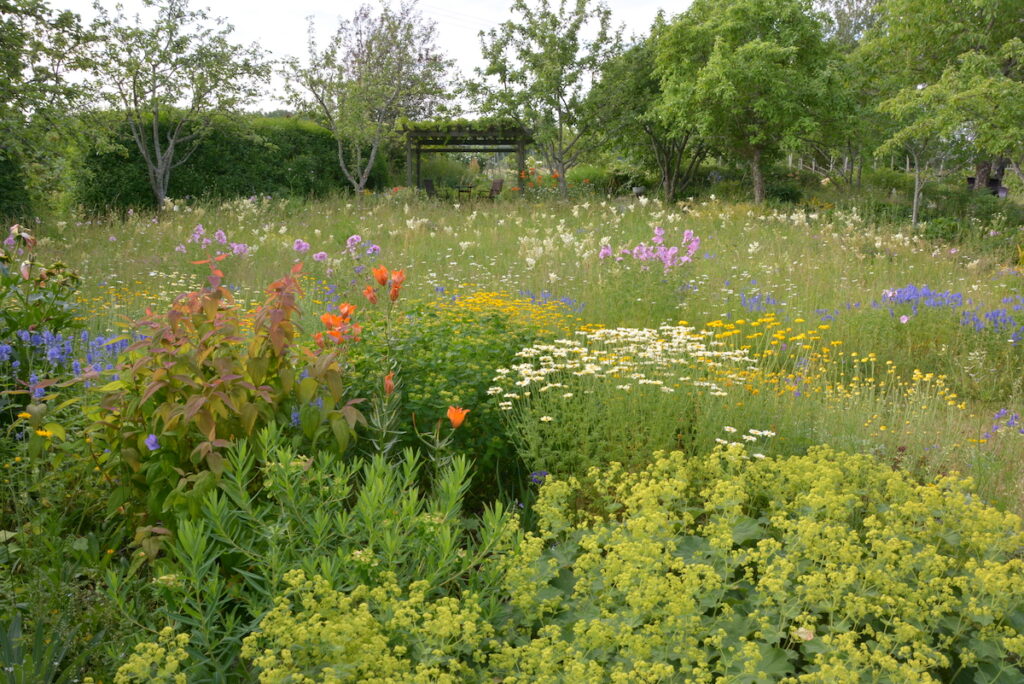A vast majority of Estonians today live in cities and can only dream of such biodiversity that dominates in Kristiina Hellström’s garden and its surroundings. Nevertheless, she is writing about it with the hope that recent country house owners could benefit from her experience.
I am not originally from Hiiumaa, however, I created my second garden here on Sarve Peninsula at the end of the previous century. Hiiumaa is rich in nature. Thus also my garden turned out to be biologically diverse, partly as planned, partly by accident. I was primarily after a beautiful garden in harmony with its surrounding landscape. The local plants, animals, birds and insects have gradually adopted my garden. Today I am also better skilled at noticing them and facilitating the wellbeing of those who I enjoy.

Plan by Kristiina Hellström.
The spirit of the place on Sarve alvar
Sarve Peninsula is actually one large alvar. This means that the thin soil on the limestone plain is mixed with stones and gravel. Areas with thicker layers of soil used to be cornfields and today they are mostly either meadows or overgrown with junipers. In places where limestone had risen to the ground or the sea had piled rocks, gravel and sand into mounds, there were pastures with junipers, birches, hazelnut and random pine trees.
Pastures here sometimes look like thin parks and this is also the case with the surroundings of my house built on a gravel hill. The two tallest trees in the garden – silver birches that were also the deciding factor for the location of the house – grow on the slope near the garden to the east of the building.
In addition to the birches, there are also other trees typical of alvar forests such as pines, rowans, young oaks with a few spruces.
Trees have never been properly felled here as the site of the future building already formed a small clearing, however, we have thinned them a little and taken down some bushes.
I have retained numerous deciduous shrubs and bushes among evergreen junipers, pines and spruces. They are rich in species and form, with their autumn displays of colour sometimes so sublimely grand that I would even dare to compare it to Japanese gardens.
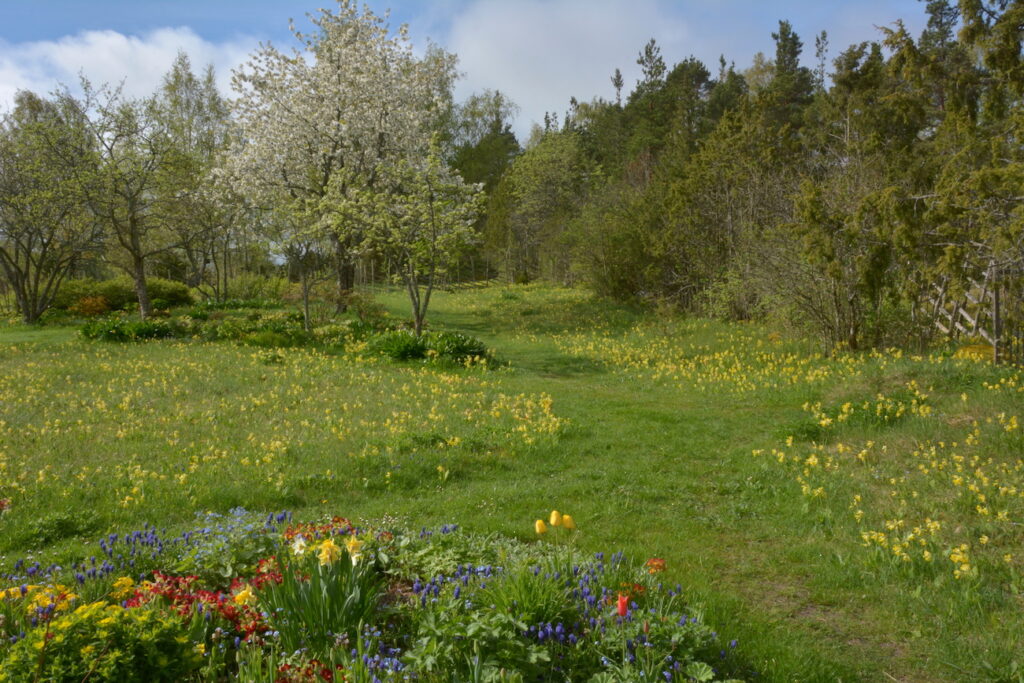
The most common ones include rose briar, buckthorn, alder buckthorn, guelder rose, barberry, fly honeysuckle and mountain currant with their berries attracting also birds. There are also hazel trees, common dogwood, bird cherries, descendants of apple trees as well as the low-growing Scandinavian cotoneaster with its red berries. Every now and again I cut and grub up the common shrubs – buckthorn and honeysuckle – as they tend to stunt the junipers and aim at conquering all bare patches of the meadow. Rejuvenation pruning works well on honeysuckle and if you do it every five years, the shrub will remain dense and round. I maintain only the larger specimens of buckthorn shaped like trees – their round crowns and flaky mossy bark can be quite attractive in winter.
The lawn around the house is retained as much as necessary and as little as possible, as the diverse vegetation on alvars blooms so beautifully that it would be a crime to mow it. The flowering peak is in spring with hepatica and cowslips, snowdrop anemones and lilies-of-the-valley. In case there is no drought in June, it will continue as a colourful carpet – the bright purple of bloody crane’s-bill, the red, yellow and orange flowers of anthyllis, rock rose, the white blossoms of northern bedstraw, white bedstraw and dyer’s woodruff, the yellow flowers of lady’s bedstraw, peach-leaved bellflower, wild strawberry, creamy strawberry, stone bramble with red berries etc. You may also come across orchids around the house: military orchids, dark red helleborine, lesser butterfly-orchids and even fly orchids.
Thus, I have attempted to retain around the house everything that is beautiful and typical of the local nature and I maintain it as a park. Every year I cut the brush a little and mow the meadows around the house in late summer with a sickle bar mower and brush cutter. As the local summers are drought-prone, you won’t get much hay.
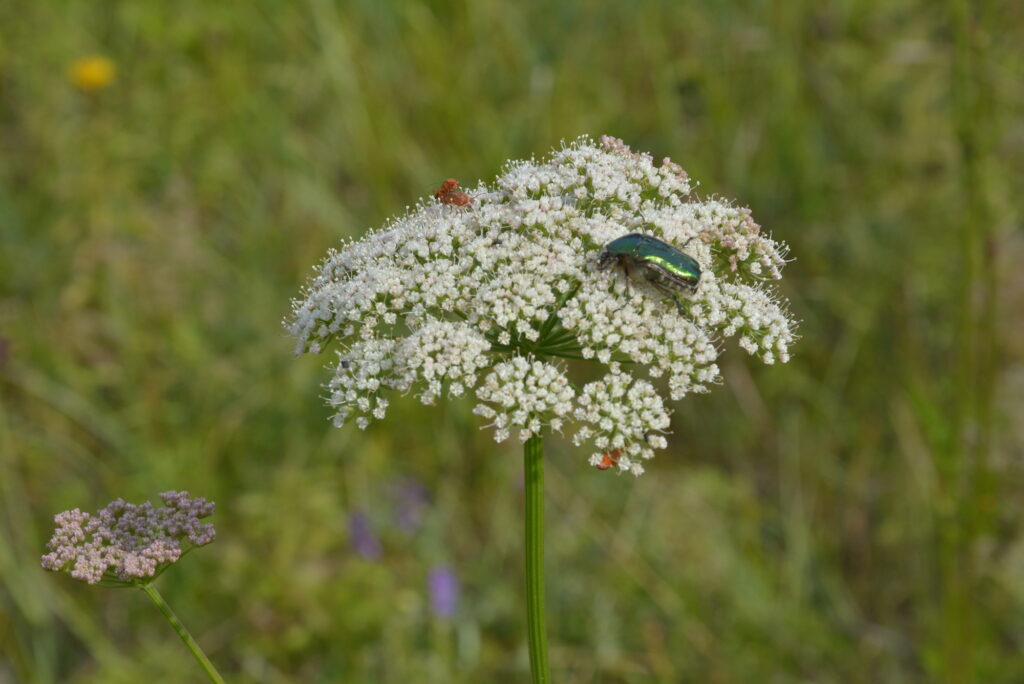
Meadows have a role to play in the garden
The actual garden was created in the corner of the former field with around 40-50-centimeters of fertile yet rocky soil on the limestone layer. The garden is thus somewhat farther away from the house next to the gravel mound and enclosed partly with a traditional roundpole fence and partly with a wire mesh fence.
With its rather regular design and flowerbeds with cultivated plants, the garden contrasts with the surroundings of the house. However, almost a third of it is similarly taken up by meadows, that is, areas that are scythed only once a year.
There is a circular flower meadow in the heart of the garden surrounded by fruit trees. It was established as an experiment among the very first things once the soil was ploughed up with a tractor.
It was weeded of all field weeds and the ground was levelled. In autumn, I sowed the flower and grass seeds I had collected from local meadows. I also rescued various plant turfs from the building site. The sowing was generally successful. At the beginning, the flowering on the meadow varied a little every year, but now it is relatively stable in terms of both species and flowering. Some years when it rains more, the vegetation is higher, when less, it is lower.
In spring, the blue and yellow of grape hyacinths and cowslips make the meadow look like the flag of Sweden. In early June, grasses with dropwort and plantain take the leading role.
Gradually, oxeye daisies come to full bloom. The peak of the natural splendour lasts from midsummer to mid-July when also pink and white mallows, peach-leaved bellflower, bedstraw, St. John’s wort, field scabious, red clover, cow wheat, rattle and many others take the stage. By late summer, the drought and heat of July have given the meadow a somewhat scorched look but you can still see the white blossoms of white carrot, the yellow of goldenrods and the purple of brown knapweed.
The garden widens up in autumn once the flower meadow has been scythed and the hay gathered and taken away. The magic circle of trees and hedges around the meadow becomes discernible. After all the flowering, also the serenity of the coarse surface is beautiful. You must not mow it too low as it would damage the flowers.
In addition to the flower meadow, there are also other meadowy patches with wild vegetation in the garden. It is enclosed by junipers and deciduous shrubs from the north and the west, with a strip of meadow extending over three to four metres. Here, the first signs of spring emerge with hepatica under the shrubs, continue with cowslips followed by dropwort, mountain clover, geranium, bedstraws and bellflowers, oxeye daisy, knapweeds, quaking grasses, the yellow blossoms of Irish fleabane and goldenrods to name only the most numerous ones. In recent years, also military orchids have settled in. As to native species, I have also planted King Solomon’s-seal, lily-of-the-valley and snowdrop anemone. The soil is always rockier and dryer on the slope than on the meadow leaving also the plants here somewhat lower. During drought, I sometimes do not scythe it at all, but this requires raking in spring. In general, I scything begins in July and ends in October if I don’t have any time earlier.
I allow some wild flowers (such as cowslip, peach-leaved bellflower, golden marguerite and oxeye daisy) to propagate in moderation on their own as it will seamlessly blend the flowerbeds with their natural background.
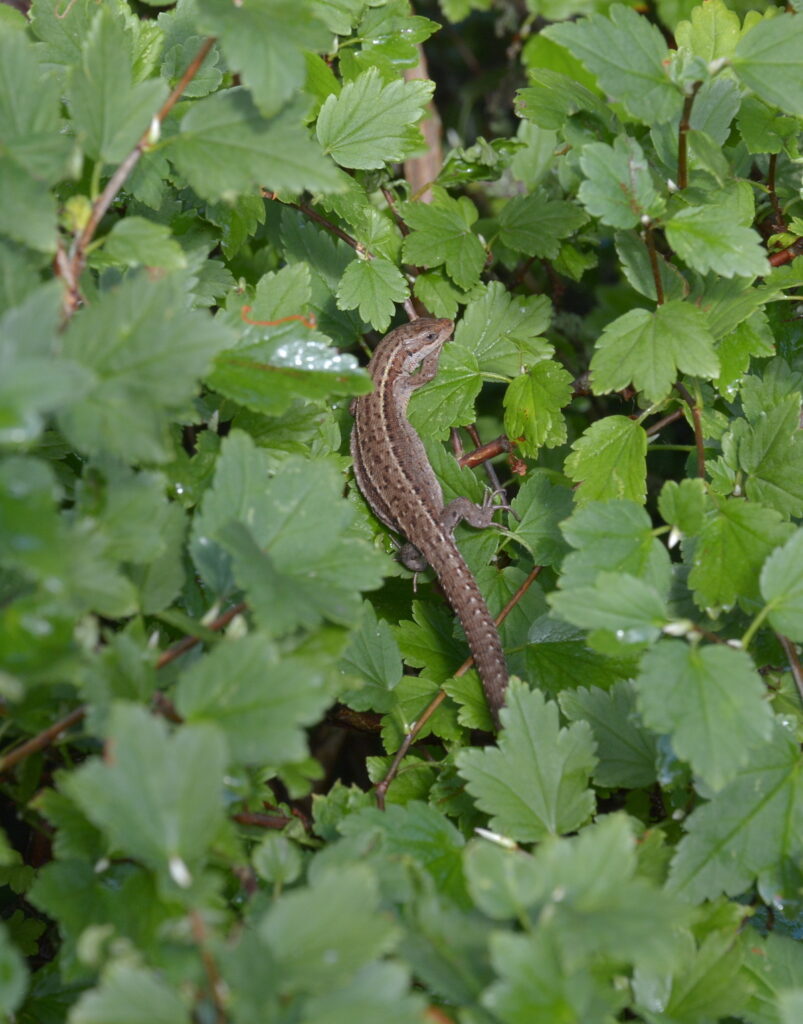
The lawn does not have to be a mere lawn
Mowing the lawn is not among my favourite activities and so I try to keep it to the minimum. There are small patches for visitors to bask in the sun and paths for walking between the flowerbeds. In some areas, frequent mowing is necessary to prevent the spread of aggressive plants. Lawns are obviously also pleasing to the eye, in my garden particularly in autumn when it finally turns green. As to the species, we initially sowed a proper grass seed mixture with white clover, but now it has largely turned into a flowering lawn. It is probably due to frequent droughts and poor maintenance, that is, lack of fertilisation and watering. The life of lawn grasses is thus hard and the lawn tends to be overrun with weeds, or rather, it adapts to circumstances. I like the fact that the adapted version is similar to the flowering lawns depicted in medieval garden pictures. As to “medieval” species, we have cowslips, daisies, wild strawberry, hoary plantain, self-heals, maiden pink, and also wood violets on the run from the flowerbed.
I do not trust anyone else with lawnmowing, especially in May and June. Then it is essential to define the boundaries between the meadows and the laws that will be walked on. The given line changes at times depending on where we have something beautiful growing. I sometimes leave tiny flowering meadow patches in the lawn. The good old Swedish Husqvarna has made the adjustment of mowing height extremely easy and so I can leave the blossoms of lower flowers (self-heals, daisies and maiden pink) intact while driving over them.
There is no mowing during drought, at times the lawn blooms quite nicely, with wild carrot and burnet-saxifrage decently low in the grass. Low bloomers also include white clover, mouse-ear hawkweed as well as wild thyme and goldmoss stonecrop planted in some particularly dry areas.
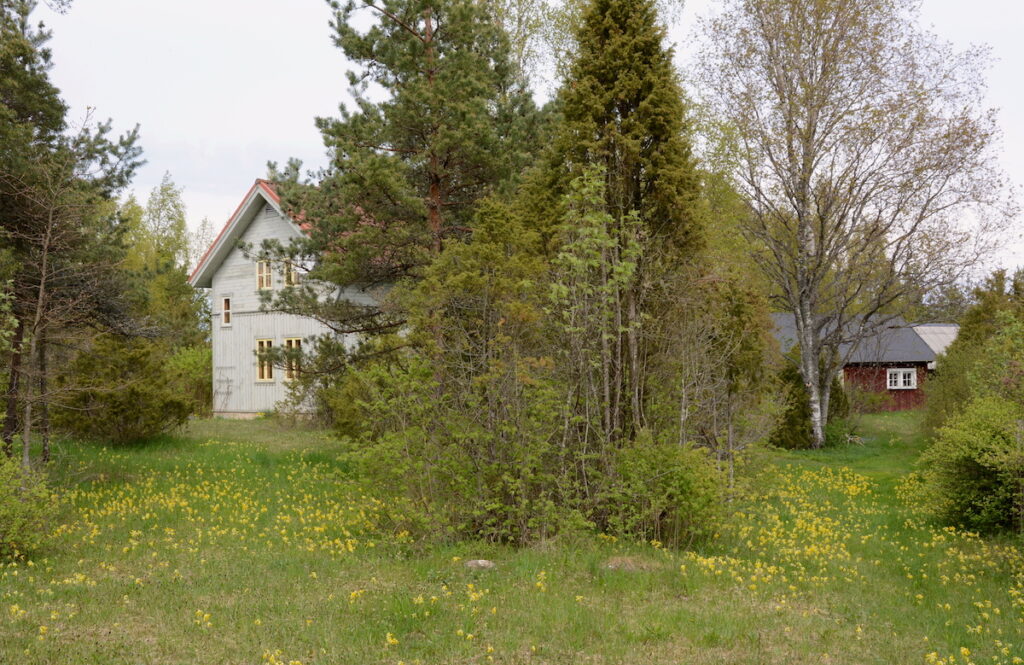
Soil as part of biodiversity
In addition to plants, I also grow soil in my garden. It is an important work requiring quite a lot of effort. Making soil mainly includes gently mixing the soil with compost and manure. The aim is to have soil enriched with worms and other soil biota that turn the sand, clay and humus into nice grit. Such soil is well aerated and holds moisture and nutrients.
I also mulch newly planted specimens with seagrass or pine bark (the latter comes from the stacked firewood). I collect the seagrass from the coast in autumn. Mulching does not only make the plants grow better, it also enhances worm activity. The garden soil must be similarly biodiverse. This is something that people do not think about so often. For instance, I hate tillers as they turn worms into ground meat.
This is the easiest way to turn a piece of lawn into a flowerbed: cover the area with a thick layer of manure, water heavily, cover the manure with cardboard (you’ll find boxes in the supermarket) and then the mulch described above. Leave it to stand for a year (or even better two) and you don’t have to worry about turfs and weeds once you create the flowerbed as there is already proper soil under the mulch.
Life with other creatures
In case there are many natural trees and shrubs, thick bushes and hedges, fruit trees and berry bushes, meadow plants and little lawn in your garden, it will be eagerly approved also by birds, insects and small animals.
A water feature in the garden would be highly valued from the biodiversity perspective, however, I haven’t bothered with creating a pond in such a dry place. Instead, I open a bird spa from spring to autumn: three clay dishes filled with water near the house that are highly popular as there is not much water anywhere at Sarve during drought. Young birds tend to be particularly enthusiastic bathers forming queues in juniper bushes. Maintaining the spa can be rather labour-intensive in high season as the water needs to be changed and dishes washed daily.
From a gardener’s point of view, there are both good and bad insects, however, if you avoid pesticides, there will be a kind of balance between particular insect species. For instance, the outburst of greenflies will sooner or later be followed by ladybirds, green lacewings and hoverflies whose larvae happily feast on them. Then again, in a biodiverse garden there is not much hope for perfect harmony between the gardener and insects. Everybody wants to survive and unfortunately it always happens at somebody’s expense.

KRISTIINA HELLSTRÖM is a landscape architect and author of the book „Minu Hiiumaa aed“ (“My Garden on Hiiumaa).
PHOTOS by Kristiina Hellström
PUBLISHED: Maja 105 (summer 2021) with main topic Landscape Architecture!

